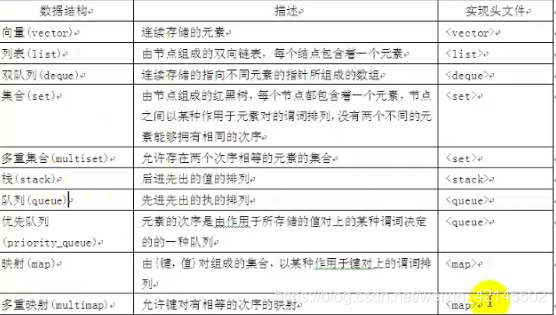1.容器的概念:
概念:用来管理一组元素
首先理解一下数据结构:数据结构研究节点与节点之间关系(主要分为:集合(节点与节点之间是独立的),数组(1:1),链表、树(一对多),图(多对多)
1.1 vector:j就是数组的容器
1.2 Deque(pop ,push)
1.3 list(双向链表)
1.4Set(集合不能放两个相同的数)Mulset (可以存放两个相同的数)
1.5 map(Key-value)


#include <QCoreApplication>
#include <iostream>
#include <stdio.h>
#include <vector>
#include <algorithm>
using namespace std;
/*
* 学习时间:2019-4-6
* 学习内容:STL:非常重要
* STL:六大组件:容器,算法,迭代器,仿函数,适配器,空间配置器
* STL:将算法与数据结构进行分离
*/
/**
*1.迭代器
*2.算法
*
*/
class Teacher
{
public :
int age;
char name[64];
};
/*容器中装对象*/
void Object_vector()
{
Teacher t1,t2,t3;
t1.age=19;
t2.age=12;
t3.age=13;
vector<Teacher> v1;//容器:把你的元素copy to the vector
v1.push_back(t1);
v1.push_back(t2);
v1.push_back(t3);
cout<<"traverse the vector"<<endl;
for(vector<Teacher>::iterator it=v1.begin(); it!=v1.end();it++)
{
cout<<it->age<<endl;
}
}
void ele_vector()
{
vector<int> v2;//定义v1 为整型的vector
// v1.push_front(-1);
v2.push_back(1);
v2.push_back(2);
v2.push_back(3);
v2.push_back(3);
//利用迭代器访问容器
//迭代相当于一个指针
for(vector<int >::iterator it=v2.begin();it!=v2.end();it++)
{
cout<<*it<<endl;
}
//算法 --查找3的个数
int num1=count(v2.begin(),v2.end(),3);
cout<<"the numeber of 3 :"<<num1<<endl;
}
/*容器中装指针*/
void pointer_vector()
{
Teacher t1,t2,t3;
Teacher *p1,*p2,*p3;
vector<Teacher *> v1; //定义一个指针
t1.age=12;
t2.age=13;
t3.age=14;
p1=&t1;
p2=&t2;
p3=&t3;
//define pointer variable value
//把t1,t2,t3,内存首地址放到了容器当中去
v1.push_back(p1);
v1.push_back(p2);
v1.push_back(p3);
//traverse the vector
for(vector<Teacher *>::iterator it=v1.begin();it!=v1.end();it++)
{
cout<<(*it)->age<<endl;
}
}
int main()
{
//对象容器
cout<<"对象容器"<<endl;
Object_vector();
//指针容器
cout<<"指针容器"<<endl;
pointer_vector();
return 0;
}